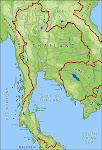
 After tourism and coconut processing the fishing trade is probably the principal occupation of many Samui families, and those of the neighbouring islands and coastal villages of Surat thani's mainland. All but driven out of the 'Fisherman's Village' of Bophut by new developments, many of the smaller boats seem to have relocated conveniently adjacent to the fish market near Big Buddha.
After tourism and coconut processing the fishing trade is probably the principal occupation of many Samui families, and those of the neighbouring islands and coastal villages of Surat thani's mainland. All but driven out of the 'Fisherman's Village' of Bophut by new developments, many of the smaller boats seem to have relocated conveniently adjacent to the fish market near Big Buddha.These small boat fishermen aim to catch anything they can, usually with a casting net. We see the same technique being used daily from the beach, sometimes netting a few sardine type small fish if they are lucky. A small boat offers the opportunity for greater scope and the chance to try for bigger fish species in open water. The technique here involves a bigger net deployed as a barrier into which fish are driven by whacking the water with a paddle or the creative use of what looks like a long handled rubber toilet plunger. The intended result being to encourage the fish to flee from the disturbance in the opposite direction and hopefully, into the net.
We've often noted two or more boats working together to deploy bigger nets and create more disturbance in unison. In season, these small boats may carry batteries and lights at night with which to attract squid which abound in the seas around the islands. But their principal catch is the small fish which, boned and gutted, can be seen (and smelled) drying on racks in fishing villages throughout the islands.
Drying fish attract swarms of flies, as in the photo above, which render the finished product a serious health hazard if eaten uncooked. Flies have got to eat and I don't have an issue with that. It's their crapping and vomiting and stomping it into the fish with their six legs that puts me off. Anyway, air-dried and deep-fried, the fish, served with a spicy mango salad and now called Pla Det Diow, becomes $30 worth of fancy starter course in a high end restaurant. Lip-smackingly good and a popular menu item among those unaware of their initial preparation, or previous diners - I'll pass thanks.
The next category of fishermen operate and often live aboard the small trawlers that land most of Samui's seafood and are a ubiquitous site at many of the islands' fishing harbours. Often seen huddled together inshore predicting the imminent arrival of a storm at sea
roped together for stability is a sure sign a storm is on its way
A third type of fishing boats operating in the water around Samui and neighbouring islands in huge fleets are dedicated to catching squid and the more meatier cuttlefish. These boats operate at night deploying high intensity lighting booms with which to attract the molluscs.
Although operating in large commercial fleets, squid fishing is very much a family affair withthe crew and their families living aboard. The boat can be home to as many as twenty people.




































